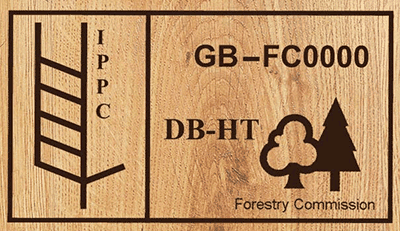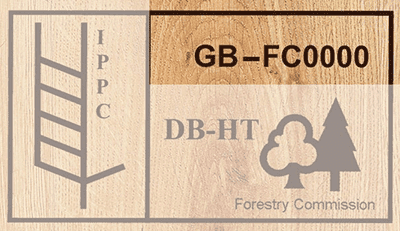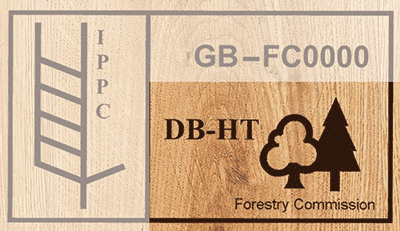Have you ever noticed stamps on the side of your pallets and wondered what they mean? Or have you ever wondered if your pallets are safe to make furniture out of or safe to burn on a log fire? Well in this blog, we’ll reveal all.
Types Of Pallets
There are around 100 standard sizes of pallets, but you’ll also find companies like Universal Pallets making custom-sized pallets. So the variety available is technically limitless.
Some pallets are made for a specific purpose, or are cleared for use in a specific geographical area. But as we know, pallets are used primarily to ship products, so a pallet that’s a few years old may have more stamps in it’s passport than you do.
Some pallets will have stamps/etching/branding on them, others can be distinguished by size or colour.
International Pallets
If a pallet is going to travel outside the UK it must bear an IPPC stamp showing a few key details:

We can break this stamp down into 3 sections to better understand what it’s telling us about this particular pallet.
The IPPC logo should always be present. The IPPC (International Plant Protection Convention) exists to prevent and control the spread or introduction of pests of plants/plant products around the world. So right away this tells you something about this pallet – the logo is present because this wooden pallet will be moving between countries and its purpose is to advise of the measures that have been taken (if any) to prevent pests from also moving between countries.

The second section that each of these IPPC stamps will include is a geo-specific identifier. The first two letters will indicate which country the pallet is from (as per ISO 3166), followed by a regional identifier. After these geo-specific codes the pallet will receive a unique registration number.

The final section of the pallet’s stamp is a little more variable. This section is used to display the treatment stamps. There may be one, two or three depending on the treatments a particular pallet has received. Please refer to the 2 character letters below for each of the codes. For pallets originating from Great Britain, the Forestry Commission logo may be present as the standard GB phytosanitary certificate, however these are no longer required and are often missed off if space is limited. But you may see some other national phytosanitary certificates on pallets originating from other countries.
If you are looking to buy wooden or plastic pallets, then visit our shop. At Universal Pallets we also offer pallet collection and other pallet related services. Get in touch or shop online today!

Treatment Stamps
Pallets are treated to eliminate insects and parasites. Any pallet that is going to travel between countries must have a treatment stamp, even if no treatments have been applied. There are a few different treatment types, some of which are no longer used in the EU. All stamps consist of a two letter code which indicates the type of treatment applied, there are 5 possible treatment stamps commonly in use:
- DB – Debarked. Just about all pallets are made from ‘debarked wood’ and all it means is that the bark of the tree has been removed from the wood used. This is done to ensure any other heat treatments can be applied efficiently to the wood.
- HT – Heat Treated. This pallet has been heat treated to eliminate parasites and insects. The wood is heated to a minimum of 56°C (60°C for hardwoods) for at least 30 minutes.
- KD – Kiln Dried. These pallets have been heated in a kiln to kill off any wood pests. Kiln drying can also help to avoid warping and fungal growth. Many lumber mills now kiln dry their wood to a higher temperature so that the wood can be categorised as both kiln dried and heat treated, marked with KD-HT.
- DH – Dielectric Heated.
- SF – Sulphuryl Fluoride. This is a fumigation method used as a biocide for wood packaging materials, introduced as a ‘safer’ alternative to Methyl Bromide (see below). With correct application these pallets will be safe to use as wood packaging materials, however we would advise against using these for pallet projects or for bonfires.
- MB – Methyl Bromide. These have been treated with a highly toxic pesticide which can be necessary in certain regions of the world where there are pests that can’t be eliminated by heat treatments. You should never use pallets with a MB stamp on for a craft project and you should never burn these pallets on a fire.
Methyl bromide treatments have been out-lawed in the uk since 2010 due to the health risks that the chemical poses. Even though it’s been illegal to use MB pallets in the UK for a long time, we know how durable pallets are, there are still some in circulation, tucked away and forgotten about. So you must always look carefully and avoid anything with an MB stamp on it.
EU Stamps
Heavy duty pallets that have the logo EUR on them are always 1200mm x 800mm and are made to exacting standards. The theory is that each one will be identical to the next.
There are several brands of EUR pallets which have their own logo stamp, eg: EPAL, MAV or UIC.
CP Stamps
CP stamps are found on all CP size pallets. There are 9 sizes in total, so you’ll see ‘CP1, CP2, CP3’, etc… These pallets are made in these 9 specific sizes and are mostly used within the Chemical Industry.
What If There Are Other Stamps/Marks
It is possible to find other marks on your pallet. These may be an indication of the lumber grading and the details of the original mill that produced the pallet pieces. Or there may be the odd pallet around that is still brand-marked, though this practice is uncommon now. If in doubt about any pallet markings, then please avoid using them for craft projects. Use only the pallets that you can be sure you understand the markings of.
Why Are Some Pallets Coloured?
If your pallet has been painted or stained in a bright colour this usually means it belongs to a pallet rental company. The colour and code on each of these pallets will tell you which rental company they belong to, here are the four most common ones:
- Red pallets: pool LPR (La Palette Rouge from Europe)
- Red pallets: pool PECO (The Pallet Exchange Company from the USA)
- Blue pallets: pool CHEP (Commonwealth Handling Equipment Pool from Australia)
- Brown pallets: pool IPP (IPP Logipal from Europe)
If you find you have a coloured pallet you should contact the company who own the pallet for advice on returning the pallet.
Do not use these pallets for your craft project, they belong to a company and you don’t want to get in trouble for using them.
Which Pallets Are The Safest For Craft Projects?
While the pallets’ markings can indicate how it’s been treated and where it’s from, they can never give you 100% of the story. Say, for example, a reused pallet had a chemical spilled onto it 2 years ago, you may not want to use this in your project.
The best way to ensure you’re using the right pallet for your project is to give our friendly team a call or email us via our contact form. We can advise the best sizes, we can find newer pallets or more weathered pallets depending on the effect you’re looking to create and we know our pallet stamps, so we’ll get you the right pallet for the job.
A Word Of Warning
If you find a scrap pallet or part of a pallet and want to use it in a craft project, please don’t. Many people find pallet boards with no stamp and pick out the pieces that look particularly ‘rustic’. These darker, older looking pieces may have been treated with Methyl Bromide, and it’s not worth risking it. Get your pallet boards from our website for as little as £0.50 and ensure that your craft project will not have any adverse health effects.
There are plenty of ways to make your pallet pieces look aged and rustic without risking your health. And if you’ve previously made a piece of furniture from pallets that could possibly have toxic chemicals on them, be sure to get rid and start again with a safe pallet – if in doubt, throw it out!
